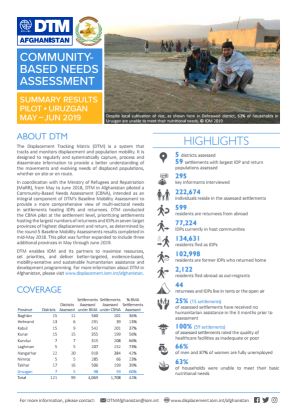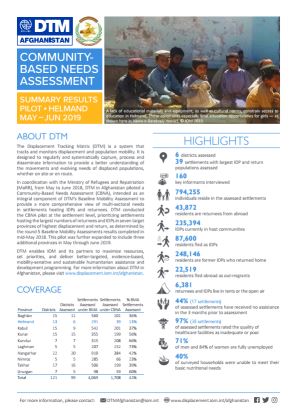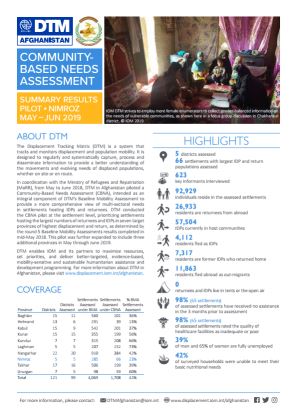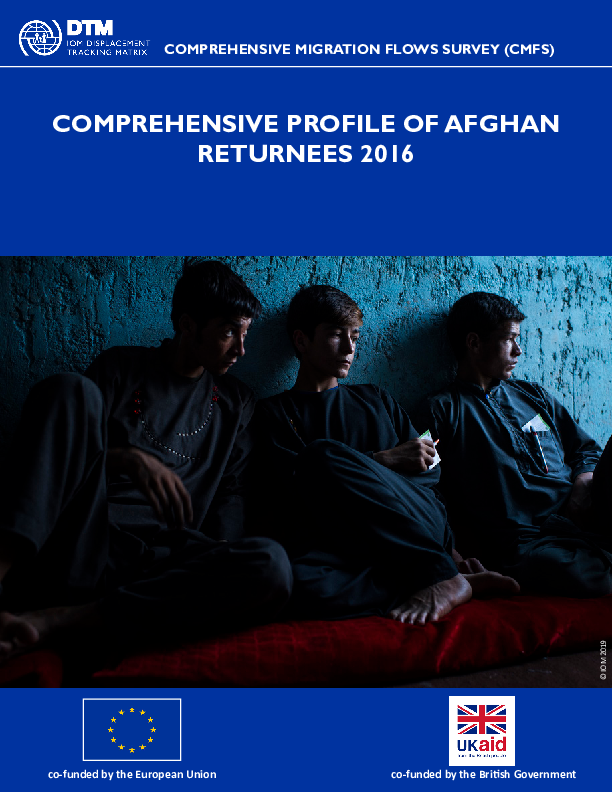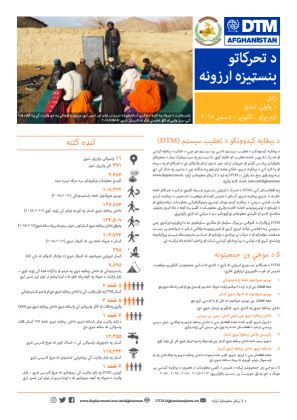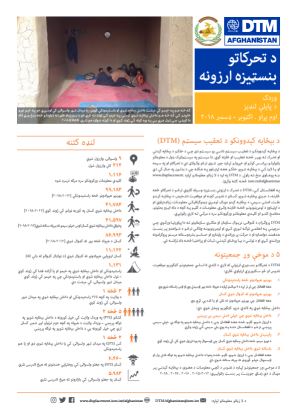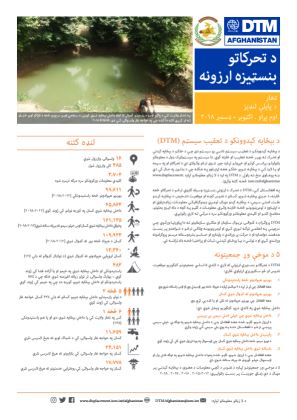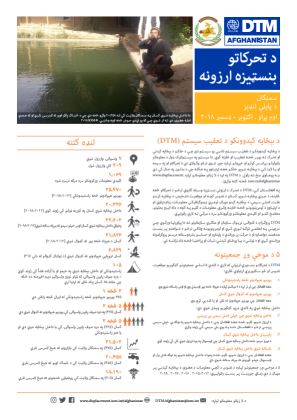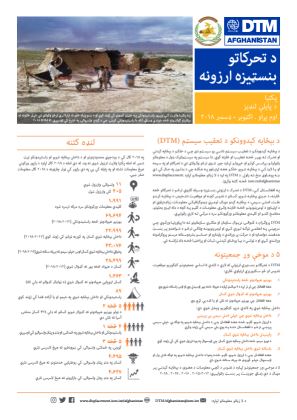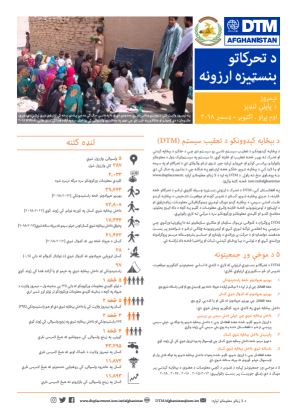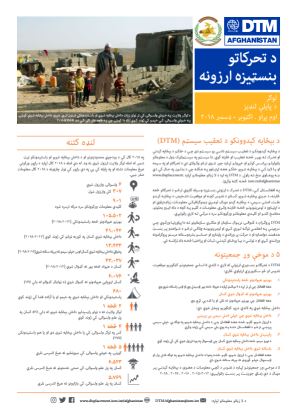-
Countries
-
Data and Analysis
-
Special Focus
-
Crisis Responses
Afghanistan
Afghanistan
IDPs tracked
Displacement Movements
4,187,000
IDMC 2023
Data collection round
About Afghanistan
The Displacement Tracking Matrix (DTM) is an information management system of tools and methodologies used to track and monitor displacement and population mobility. In Afghanistan, IOM activated the DTM programme in January 2017 in response to the substantial increase of Afghans returning home from neighbouring countries, as well as record levels of internal displacement. DTM in Afghanistan is designed to regularly and systematically capture, process and disseminate multi-layered information about the population sizes, locations, geographic distribution, movements, vulnerabilities, evolving multisectoral needs, and the drivers of migration of returnees, IDPs, migrants and mobile populations. DTM implements baseline mobility assessments, flow monitoring, registrations, and various migration surveys to provide an essential evidence base that enables decision-makers and humanitarian, reintegration and development partners to maximize resources and deliver efficient, better-targeted, mobility-sensitive and sustainable humanitarian; reintegration, community stabilization and development programming.
The value-added impact of DTM in Afghanistan is to inform action and results for people in need. DTM Afghanistan implements its activities at both the national and provincial levels. DTM works closely with other (IOM) programmes through referring identified populations in need of assistance at flow monitoring points to IOM’s Cross Border Return and Reintegration, Protection, Humanitarian Assistance, and Reintegration and Development (RADA) programmes. DTM Afghanistan also supports humanitarian partners and clusters, including WFP, FAO, UNHCR, IRC, DRC, NRC, and WHO, among many others, by providing emergency tracking updates in large-scale or sudden onset movements, such as emergency event tracking and drought response. Furthermore, stabilization and development actors, including IOM’s RADA programme, and the World Bank leverage DTM’s information to select priority communities and districts with higher concentrations of IDPs and returnees to receive reintegration and livelihoods assistance and improvements to core infrastructure and essential services. In support of health partners, including WHO, UNICEF, and the Humanitarian Health Cluster, DTM data informs the selection of priority, at-risk districts, border areas, communities, and health facilities in need of strengthened capacity, response, surveillance, and risk education for polio, TB, COVID-19, and other infectious diseases.
Contact
Modher ALHAMADANI
Senior Programme Coordinator - DTM
malhamadani@iom.int
DTM AFGHANISTAN
DTMAFGHANISTAN@iom.int
Current Donors
- Republic of Korea
- Norway
- CERF
- Canada
- Italy
- EU
- FCDO
افغانستان — ارزیابی نیازمندی های مبتنی بر جامعه: نیمروز، دوره ۱ :: می— جون ۲۰۱۹
سیستم ردیابی بیجاشدگان (DTM) از ماه می الی جون سال ۲۰۱۹ در هماهنگی با وزارت مهاجرین و عودت کنندگان (MoRR) یک برنامه آزمایشی ارزیابی نیازمندی های مبتنی بر جامعه (CBNA) را به عنوان بخش جدایی ناپذیر از ارزیابی بنیادی تحرکات (BMA) در ولایت نیمروز آن
Afghanistan — Community-Based Needs Assessment: Uruzgan, Round 1 (May — June 2019)
In coordination with the Ministry of Refugees and Repatriation (MoRR), from May through June 2019, DTM in Afghanistan piloted a Community-Based Needs Assessment (CBNA) in Uruzgan, intended as an integral component of DTM's Baseline Mobility Assessment to provide a more comprehensive view of multi
Afghanistan — Community-Based Needs Assessment: Helmand, Round 1 (May — June 2019)
In coordination with the Ministry of Refugees and Repatriation (MoRR), from May through June 2019, DTM in Afghanistan piloted a Community-Based Needs Assessment (CBNA) in Helmand, intended as an integral component of DTM's Baseline Mobility Assessment to provide a more comprehensive view of multi
Afghanistan — Community-Based Needs Assessment: Nimroz, Round 1 (May — June 2019)
In coordination with the Ministry of Refugees and Repatriation (MoRR), from May through June 2019, DTM in Afghanistan piloted a Community-Based Needs Assessment (CBNA) in Nimroz, intended as an integral component of DTM's Baseline Mobility Assessment to provide a more comprehensive view of multi-
Afghanistan — Flow Monitoring Dashboard :: Iran + Pakistan (October 2019—September 2020)
DTM's Flow Monitoring quantifies population inflows and outflows, as well as demographics, travel intentions, origins, destinations and needs of migrants, returnees and other cross-border, mobile populations, thereby informing preparedness and response planning at borders and at places of origin.
Afghanistan — Flow Monitoring Dashboard :: Iran (October 2019—September 2020)
DTM's Flow Monitoring quantifies population inflows and outflows, as well as demographics, travel intentions, origins, destinations and needs of migrants, returnees and other cross-border, mobile populations, thereby informing preparedness and response planning at borders and at places of origin.
Afghanistan — Flow Monitoring Dashboard :: Pakistan (October 2019—September 2020)
DTM's Flow Monitoring quantifies population inflows and outflows, as well as demographics, travel intentions, origins, destinations and needs of migrants, returnees and other cross-border, mobile populations, thereby informing preparedness and response planning at borders and at places of origin.
Afghanistan — CMFS: Profile of Afghan Returnees (2016)
This report is based on data collected through DTM’s Comprehensive Migration Flows Surveys (CMFS) in 2016, methodology that aims to enable a better understanding of migration flows from Afghanistan towards Europe.
افغانستان — زابل :: د تحرکاتو بنسټیزې ارزونې د پایلې لنډیز :: اکټوبر — ډسمبر ۲۰۱۸
DTM په افغانستان کې د تحرک د ارزونې بنسټیزه وسیله کاروي ترڅو تحرکات تعقیب کړي او د جبري بېځایه شویو، راستنېدونکو او کډوالو د نفوس کچه او موقعیت تشخی
افغانستان — وردک :: د تحرکاتو بنسټیزې ارزونې د پایلې لنډیز :: اکټوبر — ډسمبر ۲۰۱۸
DTM په افغانستان کې د تحرک د ارزونې بنسټیزه وسیله کاروي ترڅو تحرکات تعقیب کړي او د جبري بېځایه شویو، راستنېدونکو او کډوالو د نفوس کچه او موقعیت تشخی
افغانستان — اورزګان :: د تحرکاتو بنسټیزې ارزونې د پایلې لنډیز :: اکټوبر — ډسمبر ۲۰۱۸
DTM په افغانستان کې د تحرک د ارزونې بنسټیزه وسیله کاروي ترڅو تحرکات تعقیب کړي او د جبري بېځایه شویو، راستنېدونکو او کډوالو د نفوس کچه او موقعیت تشخی
افغانستان — تخار :: د تحرکاتو بنسټیزې ارزونې د پایلې لنډیز :: اکټوبر — ډسمبر ۲۰۱۸
DTM په افغانستان کې د تحرک د ارزونې بنسټیزه وسیله کاروي ترڅو تحرکات تعقیب کړي او د جبري بېځایه شویو، راستنېدونکو او کډوالو د نفوس کچه او موقعیت تشخی
افغانستان — سرپل :: د تحرکاتو بنسټیزې ارزونې د پایلې لنډیز :: اکټوبر — ډسمبر ۲۰۱۸
DTM په افغانستان کې د تحرک د ارزونې بنسټیزه وسیله کاروي ترڅو تحرکات تعقیب کړي او د جبري بېځایه شویو، راستنېدونکو او کډوالو د نفوس کچه او موقعیت تشخی
افغانستان — سمنګان :: د تحرکاتو بنسټیزې ارزونې د پایلې لنډیز :: اکټوبر — ډسمبر ۲۰۱۸
DTM په افغانستان کې د تحرک د ارزونې بنسټیزه وسیله کاروي ترڅو تحرکات تعقیب کړي او د جبري بېځایه شویو، راستنېدونکو او کډوالو د نفوس کچه او موقعیت تشخی
افغانستان — پروان :: د تحرکاتو بنسټیزې ارزونې د پایلې لنډیز :: اکټوبر — ډسمبر ۲۰۱۸
DTM په افغانستان کې د تحرک د ارزونې بنسټیزه وسیله کاروي ترڅو تحرکات تعقیب کړي او د جبري بېځایه شویو، راستنېدونکو او کډوالو د نفوس کچه او موقعیت تشخی
افغانستان — پنجشیر :: د تحرکاتو بنسټیزې ارزونې د پایلې لنډیز :: اکټوبر — ډسمبر ۲۰۱۸
DTM په افغانستان کې د تحرک د ارزونې بنسټیزه وسیله کاروي ترڅو تحرکات تعقیب کړي او د جبري بېځایه شویو، راستنېدونکو او کډوالو د نفوس کچه او موقعیت تشخی
افغانستان — پکتیا :: د تحرکاتو بنسټیزې ارزونې د پایلې لنډیز :: اکټوبر — ډسمبر ۲۰۱۸
DTM په افغانستان کې د تحرک د ارزونې بنسټیزه وسیله کاروي ترڅو تحرکات تعقیب کړي او د جبري بېځایه شویو، راستنېدونکو او کډوالو د نفوس کچه او موقعیت تشخی
افغانستان — پکتیکا :: د تحرکاتو بنسټیزې ارزونې د پایلې لنډیز :: اکټوبر — ډسمبر ۲۰۱۸
DTM په افغانستان کې د تحرک د ارزونې بنسټیزه وسیله کاروي ترڅو تحرکات تعقیب کړي او د جبري بېځایه شویو، راستنېدونکو او کډوالو د نفوس کچه او موقعیت تشخی
افغانستان — نورستان :: د تحرکاتو بنسټیزې ارزونې د پایلې لنډیز :: اکټوبر — ډسمبر ۲۰۱۸
DTM په افغانستان کې د تحرک د ارزونې بنسټیزه وسیله کاروي ترڅو تحرکات تعقیب کړي او د جبري بېځایه شویو، راستنېدونکو او کډوالو د نفوس کچه او موقعیت تشخی
افغانستان — نیمروز :: د تحرکاتو بنسټیزې ارزونې د پایلې لنډیز :: اکټوبر — ډسمبر ۲۰۱۸
DTM په افغانستان کې د تحرک د ارزونې بنسټیزه وسیله کاروي ترڅو تحرکات تعقیب کړي او د جبري بېځایه شویو، راستنېدونکو او کډوالو د نفوس کچه او موقعیت تشخی
افغانستان — ننګرهار :: د تحرکاتو بنسټیزې ارزونې د پایلې لنډیز :: اکټوبر — ډسمبر ۲۰۱۸
DTM په افغانستان کې د تحرک د ارزونې بنسټیزه وسیله کاروي ترڅو تحرکات تعقیب کړي او د جبري بېځایه شویو، راستنېدونکو او کډوالو د نفوس کچه او موقعیت تشخی
افغانستان — لوګر :: د تحرکاتو بنسټیزې ارزونې د پایلې لنډیز :: اکټوبر — ډسمبر ۲۰۱۸
DTM په افغانستان کې د تحرک د ارزونې بنسټیزه وسیله کاروي ترڅو تحرکات تعقیب کړي او د جبري بېځایه شویو، راستنېدونکو او کډوالو د نفوس کچه او موقعیت تشخی
افغانستان — لغمان :: د تحرکاتو بنسټیزې ارزونې د پایلې لنډیز :: اکټوبر — ډسمبر ۲۰۱۸
DTM په افغانستان کې د تحرک د ارزونې بنسټیزه وسیله کاروي ترڅو تحرکات تعقیب کړي او د جبري بېځایه شویو، راستنېدونکو او کډوالو د نفوس کچه او موقعیت تشخی
افغانستان — کندز :: د تحرکاتو بنسټیزې ارزونې د پایلې لنډیز :: اکټوبر — ډسمبر ۲۰۱۸
DTM په افغانستان کې د تحرک د ارزونې بنسټیزه وسیله کاروي ترڅو تحرکات تعقیب کړي او د جبري بېځایه شویو، راستنېدونکو او کډوالو د نفوس کچه او موقعیت تشخی
Pagination
Pagination
Pagination
- First page
- Previous page
- 1
- 2
- 3
- 4
- 5



